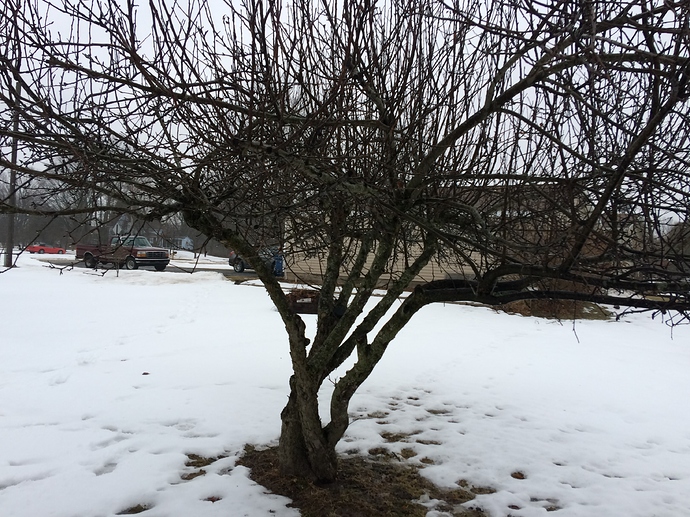When its time what limbs woild you keep? Im thinking, just the 4 outside/corners? Other ideas?
In laws want this one changed over. The current type is shaped oddly like calville de blanc but drops in september and dont taste well. It is a yellow apple, i should have pics somewhere.
Those water sprouts look inviting to me. I learned here that those are great to graft to. Bend them over to the horizontal while they are still supple and graft to them, planning to remove the branch they sprang from the following year. @alan can give you better instructions but I’ve worked with it a bit and it’s a very good way to go because it’s straightforward to graft to similar-sized wood, and your new scion has ample plumbing to back it up.
Regardless of the final shape, it looks like a rather mature tree so I might suggest leaving a good portion of the tree untouched this season and graft it over a period of three or four years. Otherwise I believe that there is a fair chance that it will die in a year or two if you try to completely topwork in one season. Been there, done that, unfortunately.
The argument I guess I have is what I did w/ this pear tree thats right next to this apple.
I did leave a big limb on it that I’m going to cut out this year. Perhaps do that with this apple? Cut off the main branches I want to graft and leave the other branches for this year then once the grafts are established next spring (2019) take those old remaining branches out…
Thoughts?
You did it right with the pear. I can’t distinguish a large nurse branch from your photos but you said “I did leave a big limb on it that I’m going to cut out this year.”
So basically what you need to know is that it is recommended that you leave 4" width maximum stumps to bark graft (change varieties).
Leave a long nurse branch beneath the other branches you are going to top work. Cut the others off completely and put your bark grafts in. Use just as you did with the pear, long stakes to tie the new growth to at foot intervals. Tie them somewhat loose so they have room to grow/widen but not loose.
From your photo of the apple, here’s what I see:
Green cuts are where to bark graft. What I tried to show is you are directing the newly placed scions to grow at desired angles. On the right of the tree is what appears (3) trunks. The furthest back one I tried to put a green line where the growth would direct away from the two other limbs. Of course you’ll have the correct view in person.
Just cut those limbs so the scions won’t grow toward one another. If you have to and it’s perfectly alright to do so, when you insert the scions, insert them at an angle so they are being directed to a new direction. So if a limb is angled to the right for example, slip the scion under the bark directing it toward the left or whatever direction the growth needs to be headed towards.
Dax

Next year if the grafts were successful and there’s a lot of new growth to support the trees basic needs, cut this years nurse limb back so you can graft onto it next year should you wish to add another variety.
nice visual idea @Barkslip thanks a bunch.
I know the different angles of the tree i took made it confusing but i was trying to show the entire tree shape. This will be a fun project, just like the pear was.
I would bark graft and no larger than 3-4 inches. Any larger and the limb may rot before the scion grows over.
Another concern is the graft should be the highest bud on the tree so cutting off half the limbs and leaving
the others taller than the graft may be setting you up for failure. I’d cut all the limbs at 3 inches and bark graft
all of them. You will have to wait until the tree is growing and leafed out to do a bark graft as the bark must be slipping.
Yes I did bark grands and/or rind grafts on the pear last year at that time, worked slicker than heck.



